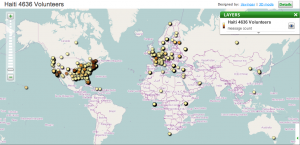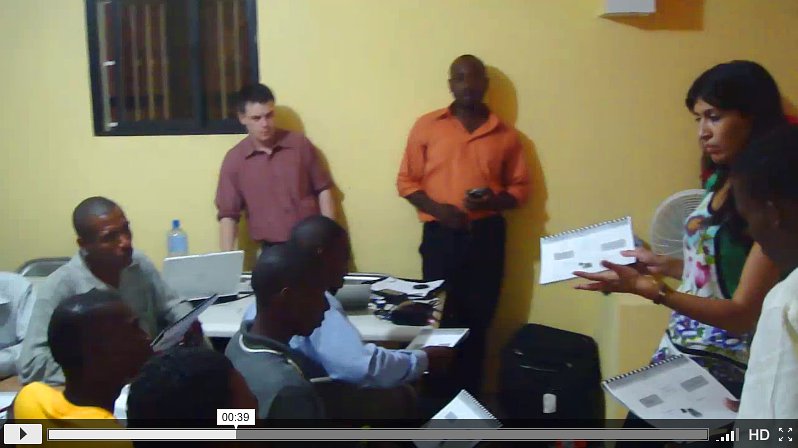
The global locations of the 4636 volunteer translators
The heart and soul of 4636 have been its least visible members: the Kreyol and French-speaking volunteers. They are the hundreds of people from around the world who have joined us online to translate, categorize and geo-locate each message. If you have been helping with the translations, then on average you have delivered the first food and water to a person in Haiti for every message you have translated. Mission 4636 has directed emergency response teams to hundreds of medical emergencies and directed the first food and water to tens of thousands. Every single message has gone through this teams of translators – about 30,000 messages so far.
The Mission 4636 translators have been ahead of the curve on every part of the relief effort. From launch, they were collating maps about aid stations and food distribution centers. For non-emergency texts to 4636 they were using these maps and replying to people individually with directions, acting as the first open dialogues between relief efforts and people directly affected by the disaster. In contact with their social networks in Haiti, they were updating the open source maps of the relief efforts for all aid agencies to exploit and passing all information by text message back to individuals on the ground. When a message came to 4636 that simply asked to tell some overseas relative that the person was alive and well, they forwarded those too.
They were also ahead of the curve in terms of turning this into a sustainability. Is was also their initial idea to transition the service to paid workers in Haiti, allowing a long-term sustainable future for 4636 in Haiti that is creating 100 jobs where they are needed most.
Admiral, alex, aline, Anya_Petrova, Apo, Aramys, AudreyUH, BLR, Brian, Carline, Caroline, Carter, Christina_Xu, Claire, Connie, csik, Dalila, Danya, Douglas, duygu, Emmanuel, fabienne, Fio, Fiona, Fred-Michel, GeekNomad, gerhard, Gina, Girlgeek, Gis, Giscard, gsvaughan, Guerda, GundarK, gwadaboy, GwoNeg, Gwotet, gwyn, Haitianboy, J-R, J_Positivity, Jackie, jazzunionhaiti, Jenn, Jennifer, Jeremy, Jim_mwen, Jimi, Jis, Johanne, JoshNesbit, JYOOP, ka, kaneila, Karina, Karine, Kat, Kenny, Kenold, kouraj, lago, ljonas, Lunecee, M300_Ministrie, marc, marc_uh, maribux, MarjorieJ, Mark, mark_d, Mary_Jane, Meg, Mel, Midy, mik, mnm, Montreal, mrJ, myrka, Nan, Nancy, nick, Nita, Paquette, patbam, Patricia, pheelin_eerie, pouchon, Prez, pyrl, RalphArnoux, RAM, Raymond, Rebecca, regine, rescuemehaiti, RJJ, RN4Life, Robens, Robert_Montgom, Robert_Munro, Robs, ron, Ronald, ronny, Rose, S_Michel, sandra, sara, Sarah, SarahU.H, Sarah_B, Sebastien, smile, sophiap, stephan, Stuart_Moffatt, Stephane, Susana, SuzetteNo1, sxpert, sxwork, Ti_Zwazo, TiWosignol, Tom, UNIONHAITI, yami, Yamille
Some of names of the volunteers, taken from the volunteer chat
They are the only irreplaceable step in the 4636 process. Every technology that was vital to the 4636 effort existed a decade ago – the text messages are read into a feed, plotted on map, and streamed back to responders on the ground. The volunteers collaborate in a simple chat room. The media might be reporting that 4636 is triumph of technology, but it has really been a triumph of people. The part that didn’t exist a decade ago was the belief of the volunteers that they could come together online and not doubt that collectively they were making a real-time difference on the ground.
One month on and we are still the only such emergency reporting service available to every Haitian. The maps alone are the most trusted source of information for many agencies. This means that a dedicated group of Haitian diaspora with cellphones were able to create richer geolocated intelligence than the many of efforts of the Red Cross, the UN and joint military response (this is not a competition, of course – these groups all take advantage of these maps and are the ones who inform us of their accuracy). The reason for this is that the volunteers bring vital local knowledge to interpreting the text messages – turning Kreyol into English and even the nicknames of suburbs into precise coordinates. A typical slice of the volunteer chat-room:
Dalila: I need Thomassin Apo please
Apo: Kenscoff Route: Lat: 18.495746829274168, Long:-72.31849193572998
Apo: This Area after Petion-Ville and Pelerin 5 is not on Google Map. We have no streets name
Apo: I know this place like my pocket
Dalila: thank God u was here
And then this from the responders:
“just got emergency SMS, child delivery, USCG are acting, and the GPS coordinates of the location we got from the translators were 100% accurate!”
It has taken much courage from the volunteers to decide to step in and become part of the emergency response. We might never even know your name, but we owe you all our thanks for the success of 4636.


